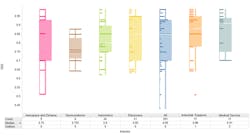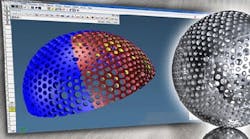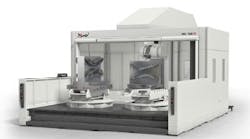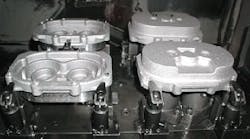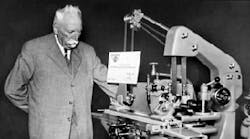Boeing Co. has purchased machine tools in Cincinnati, and is sending them to Russia to cut titanium so that the chips will be nearer the titanium smelting process, and so that chips and scrap can stay nearer the source of the metal.
Boeing’s new 787 aircraft – known as the “Dreamliner” – is expected to set records in the use of titanium. A greater percentage of titanium and composites will be used on that airliner than on any previous passenger liner, and Boeing reportedly needs and will continue to need vast amounts of machining to support the expected sales of that plane.
Meanwhile, the war in Iraq is causing great wear and tear on the U.S. military’s fleet of fighter jets, helicopters and unmanned aircraft, and that is coinciding with the aging of the civilian fleet of business jets and helicopters that are used domestically for everything from television news reporting to medical life-flights.
The result is a burgeoning need for shops that can cut titanium, aluminum and the high-nickel content alloys that are used in the manufacturing of airplanes, helicopters and other aircraft.
Machine shops – the shops that make parts to provide to assembly operations that build components for aerospace companies – typically are on the third-tier of the supply chain and have a critical role in the success of major programs.
Boeing has said it is planning to outsource 70 percent of all of the parts for its 787 aircraft, and that plane promises to be one of the company’s all-time best selling models. Meanwhile, Lockheed Martin continues to look for sources outside of its own facilities to produce nearly half of the parts it needs for the variety of aircraft and aerospace programs it manages.
Getting started on as an aerospace supplier is a daunting, but not impossible mission, but takes dogged effort and planning.
The Supplier Excellence Alliance (www.seaonline.org) a non-profit group of Tier 1 and sub-tier companies in the aerospace industry says that aerospace companies are looking for suppliers that represent businesses with mature processes, and can provide a stable and sustainable, full pipeline of parts. So, the first requirement to landing a contract for the aerospace industry is being able to produce and deliver quality parts. If a shop cannot accomplish that, it’s already out of the running.
The Supplier Excellence Alliance carefully defines “mature processes,” and points to them as the next requirement for entry – and to stay – in the aerospace business.
Many aerospace companies have individual supplier portals on their Internet sites where they provide detailed information about what they look for in a supplier and the processes they use to find suppliers and maintain their supplier bases. In almost every instance, the Tier 1 companies’ supplier portals are divided into separate areas: One for would-be suppliers, and one for existing suppliers. The portals for existing suppliers are restricted areas that require pass codes to open.
However, the portals for would-be suppliers provide a large amount of information on the Tier 1 companies and, in many instances, on the second tier companies that build subassemblies for them. That information includes the basic requirements the company looks for in the multiple tiers of its supplier ranks, and fundamental information on how a new supplier might get business and, in some cases, the companies offer information on how would-be suppliers can be trained to get into the business.
While many of the large aerospace companies, including Boeing Co. and Lockheed Martin Corp., have easily identifiable hot buttons to supplier portals on their homepages, other companies do not provide such easy access and may require the use of their search engines to find information on how to become a supplier to them.
However, one of the least discussed aspects of becoming an aerospace supplier, and one that typically is not found in the information the Tier 1 companies provide to their suppliers, is the documentation that the industry requires.
While many of the leading companies are striving to eliminate “paperwork,” they continue to require increasing amounts of documentation so that every part and every bit of material used in a system is recorded and remains traceable to its origin over the life of the final product it goes into.
On the Lockheed Martin Internet page for suppliers, John Hatch, Lockheed Martin’s vice president for Global Supply Chain Management, says Lockheed Martin is committed to electronic commerce and is moving toward a paperless procurement system, and that has been a long-standing goal for many of the Tier 1 companies. However, they have not yet achieved that goal, and it has to be noted that becoming “paperless” does not diminish the intense amount of documentation that the aerospace companies require from their suppliers.
In addition to getting information directly from the aerospace companies themselves, trade associations and conferences provide details on how the industry works and help to build networks of people that can lead to business.
Shops that are in the aerospace industry note that once they have put their foot in the door and landed a contract, it requires a dedicated effort to stay in the aerospace business, and that the dedication is measured primarily by a reinvestment in the industry. That reinvestment is needed to be competitive and to stay up on the latest technology that is needed to turn out the products the industry needs and, as the process maturity level list from the Supplier Excellence Alliance demonstrates, the technology that the industry demands goes beyond machinery and software. It often requires learning new ways of doing business, and re-learning ways of doing business as the industry evolves.
| The Supplier Excellence Alliance’s Process Maturity Levels: |
| 5 – The process shows continuous positive trends and benchmarks world-class. |
| Tier 1 and Tier 2 aerospace companies and their Internet sites: | |
| Applied Engineering | www.appliedengineering.com |
| Boeing Company | www.boeing.com |
| Bombardier Aerospace Corporation | www.bombardier.com |
| Cessna Aircraft Company | www.cessna.com |
| Dresser-Rand Group | www.dresserrand.com |
| Hamilton Sundstrand | www.hamiltonsundstrandcorp.com |
| Honeywell Aerospace | www.honeywell.com |
| Lockheed Martin | www.lockheedmartin.com |
| Northrop Grumman Integrated Systems | www.is.northropgrumman.com |
| Northrop Grumman Space Technology | www.st.northropgrumman.com |
| Parker Aerospace | www.parker.com |
| Pratt & Whitney | www.pratt-whitney.com |
| Rockwell Collins, Inc. | www.rockwellcollins.com |
| Textron, Inc. | www.textron.com |
| United Technologies Corporation | www.utc.com |
